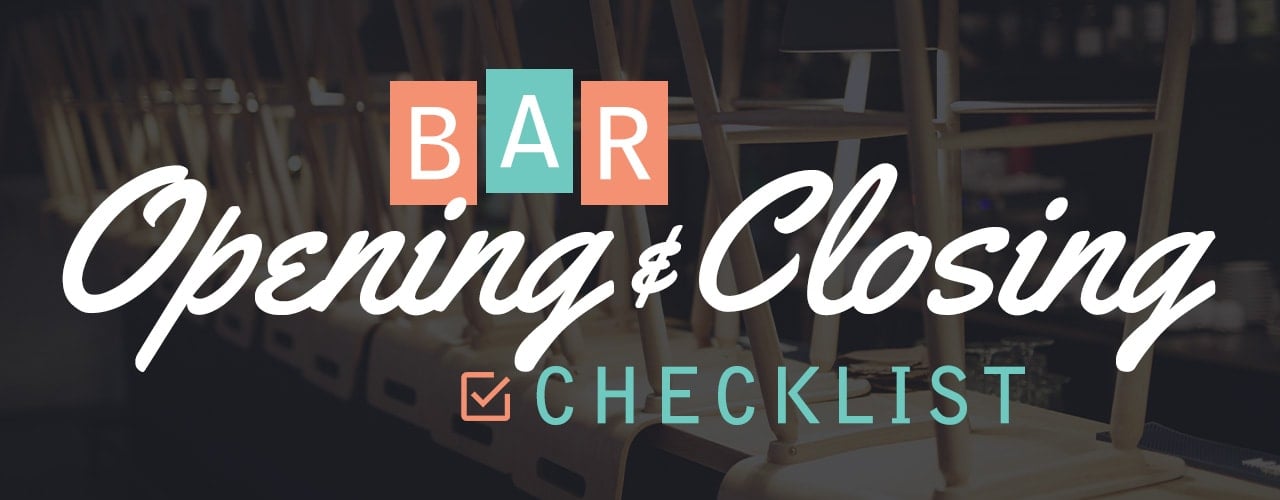
Whether you already run a successful bar or you're opening a new business, a bar opening and closing checklist is one of the best ways to make sure your bar, nightclub, or pub is clean, organized, and ready for the next day. These bar checklists include the bar opening procedures and bartender closing duties that your staff needs to complete at the beginning of the day and before leaving each night, such as cleaning, restocking, storing, organizing, and locking up.
We created a comprehensive bar opening checklist, along with a bar closing checklist that you can use to keep your bar organized and secure. Use the following buttons to download our printable PDFs:
Printable Bar Opening Checklist PDFPrintable Bar Closing Checklist PDF
Bar Opening and Closing Video
To learn how to keep your bar looking spotless with effective opening and closing procedures, check out the video below:
Bar Opening Checklist
Before you can open your doors each day, there are a few bar opening procedures your staff should follow before turning on the open sign. To ensure that you're ready for customers, follow these six steps for opening a bar for the day:
1. Do a Preliminary Building Check
When your staff first arrives, they should do a quick scan of the property inside and out to make sure everything looks in order.
- Clear any debris the might have collected overnight outside your building, on the sidewalks, in the doorways, or on the windows
- Once inside, check for odors, trash, spills, or items out of place
- Decide if the floors need to be vacuumed
- Empty and reset pest traps
2. Polish and Sanitize Surfaces

To make a good impression on your customers, you'll want to make sure your bar is sparkling clean, from the counters to the glasses.
- Wipe down countertops with a sanitizing solution
- Wipe down stool seats and tabletops to clear away any dust that may have collected overnight
- Polish the glassware that was air drying from the previous night
- Polish any silverware you plan to use during the day, including barware
- Dust any alcohol bottles on display
- Clean faucets and taps with sanitizer
3. Take Inventory of Beverages
Once you make sure everything in your bar looks in order and presentable, it's time to ensure that your beverage stock is ready for day's service.
- Count your bottle inventory to ensure nothing was stolen overnight
- Check the levels of your wine, liquor, and mixer bottles; take note of what stock needs to be ordered
- Stock your back bar cooler
- Check your keg levels; take note of which ones may 'kick' next and prepare a backup to replace during the shift
- Test the taps and clear the drain lines by pouring out a little beer from each keg
4. Set Up the Room

After you've completed your inventory check, set up your space so it is ready to host customers.
- Set up the tables and chairs
- Set up your service bartending supplies you'll need for your shift
- Set out clean bar towels
- Prepare the cash drawer for service
- Roll the flatware into clean napkins
5. Prep and Refill the Condiment Bar
With your station set up, it's time to prep your condiments and garnishes for the drinks on your menu.
- Wash and cut the fruit for the day
- Refill bar garnishes, including rimming salt and sugar, olives, and cherries
- Squeeze fresh citrus juice to pair with drinks
6. Refill the Ice Bin
Ice is considered food in the foodservice industry, so your ice must be as fresh as your other drink ingredients.
- Empty out the underbar ice bin
- Melt any ice build-up with hot water
- Wipe out the bin
- Stock the bin with fresh ice
Bar Closing Checklist
There are six bar closing procedures your bar employees need to complete to close your bar at the end of the day. These steps can be carried out in different orders, depending on your flow, but we'd suggest leaving cleaning and mopping the floors for the end to prevent your employees from making any potential additional messes while closing.
1. Empty Out and Lock Up

For the first step of your bar closing checklist, check your restaurant for any remaining customers. Locking up should be the first step because you want to make sure everyone is out before you start cleaning and counting the money. Ensuring every patron is out of the bar at the end of the night keeps your customers safe and protects your staff and business.
- Ensure the dining area is clear of customers
- Check the restrooms for any lingering guests
- Check that the kitchen is empty
- Check accessible closets to ensure no one is hidden in them
- Lock up patio furniture
- Lock the entrances; set any alarms before leaving for the night
- Turn off televisions, radios, LED signs, and additional lights
2. Count the Money
Once you've locked up, you can begin counting the money and cleaning up for the night. Along with counting the money, you'll also need to distribute the night's tips. You should have an established tipping system, such as working on an individual basis, daily pools, or other ideas that distribute the money fairly.
- Distributing tip pool
- Balancing cash registers
- Securing money in safes
3. Store Perishables
Storing and refrigerating perishables is an important way to save money at your bar. Every drink or ingredient that you save overnight is money going toward profits.
- Store fruits and garnishes in plastic bags or containers to prolong their freshness
- Refrigerate any pre-made mixed drinks such as sangria or punch
- Refrigerate cocktail ingredients such as soda and juice
- Lock up expensive beers and liquor bottles
- Put bar snacks back in the pantry
4. Organize and Date

Organizing your bar and kitchen is an important task, and it ensures that opening will run smoothly on the following day. Additionally, dating your food and alcohol lets you know when it was opened and if it's still good to use. Practicing proper dating and organization is essential for passing health inspections.
.- Date newly opened bottles of wine and liquor
- Clean menus and recycle old ones
- Label all of the fresh ingredient containers
5. Clean Everything
Cleanliness is one of the prime indicators of a professional and well-managed bar space, and whether it's dust on the shelf, rings on the countertop, or a napkin that didn't make it to the trash, unclean appearances can speak volumes about your business, particularly to health inspectors. Cleaning is probably the most labor-intensive part of the closing checklist, but if your staff all works together, it can go quickly.
Here is a short list of important cleaning tasks that need to be completed every night:
- Wipe down countertops
- Wipe down the soda gun
- Clean out soda gun holsters
- Remove clogs from floor drains
- Wipe down your speed rails
- Clean the outside of liquor bottles if any product has spilled
- Load the dishwasher and clean glassware with bar glass cleaners
- Drain off dirty dishwater and scrub down your sink
- Wash other smallwares like muddlers, jiggers, and stirrers
- Wipe down beer taps and thoroughly clean them once a month
- Sweep the floors in the front- and back-of-house, then mop
- Clean out blenders
- Clean the bathrooms thoroughly
- Leave all of your glassware, smallwares, and equipment out to air dry, ensuring they're clean for the following day
6. Refill Disposables
Refilling disposables behind the bar can help save time when opening the following day and keep your bartenders quick on the draw during service. Any single-use product should be stocked for the next day, no matter how inconsequential it may seem. Here is a list of a few bar disposables that need to be refilled every day:
- Toothpicks
- Drink Umbrellas
- Stirrers
- Straws
- Napkins
A bar opening and closing checklist is imperative to maintaining the sanitation, organization, and streamlined operation of your business. Having written bar opening duties ensures your staff has constant access to the established protocol while a bar closing duties list can make closing up go smoothly every time. Whether you're training new hires or providing a refresher for seasoned veterans, bar checklists are great tools for making your bar more efficient.





